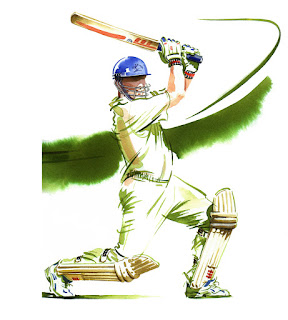Rules :
Cricket is a bat and ball game, played between two teams of eleven players each. One team bats, attempting to score runs, while the other bowls and fields the ball, attempting to restrict the scoring and dismiss the batsmen. The objective of the game is for a team to score more runs than its opponent. In some forms of cricket, it is also necessary to dismiss the opposition in order to win the match, which would otherwise be drawn.
Game format :
Cricket is a bat and ball game, played between two teams of eleven players each. One team bats, attempting to score runs, while the other bowls and fields the ball, attempting to restrict the scoring and dismiss the batsmen. The objective of the game is for a team to score more runs than its opponent. In some forms of cricket, it is also necessary to dismiss the opposition in order to win the match, which would otherwise be drawn.
Game format :
A cricket match is divided into periods called innings . It is decided before the match whether the teams will have one innings or two innings each. During an innings one team fields and the other bats. The two teams switch between fielding and batting after each innings. All eleven members of the fielding team take the field, but only two members of the batting team are on the field at any given time. The order of batsmen is usually announced just before the match, but it can be varied.
A toss is held by the team captains just before the match starts: the winner decides whether to bat or field first.
At each end of the pitch is a wooden target called a wicket; the two wickets are placed 22 yards apart. The pitch is marked with painted lines: a bowling crease in line with the wicket, and a batting or popping crease in front of it. The wicket is made of three vertical stumps supporting two small horizontal bails. A wicket is put down if at least one bail is dislodged, or one stump is knocked down (usually by the ball, but also if the batsman does it with his body, clothing or equipment). This is also described as breaking, knocking down, or hitting the wicket – though if the ball hits the wicket but does not dislodge a bail or stump then it is not considered to be down.
At any instant each batsman "owns" a particular wicket and, except when actually batting, is safe when he is in his ground. This means that at least one part of his body or bat is touching the ground behind the popping crease. If his wicket is put down while the ball is live and he is out of his ground then he is dismissed, but the other batsman is safe.
The fielding team's other nine members stand outside the pitch, spread out across the field. The fielding captain often tactically changes their position between balls.
There is always an umpire at each end of the pitch.
The bowler usually retreats a few yards behind the wicket, runs towards it , and then releases the ball over-hand as he reaches the bowling crease. The ball can be bowled so that it bounces on the pitch, lands exactly on the crease , or crosses the crease without bouncing. If the ball goes above the waist without bouncing then that delivery is declared as illegal delivery.




Comments
Post a Comment